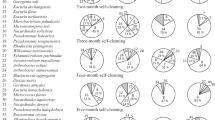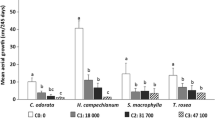Abstract
Purpose
Nowadays, crude oil contamination of soil is one of the widespread environmental problems. In this paper, we examine the impact of oil contamination on individual components of soil ecosystems at the physicochemical and biological levels.
Materials and methods
We investigated the hydrophysical properties, benzo[a]pyrene content, phytotoxicity, and toxicity for test organisms (Daphnia magna Straus, Escherichia coli) of the experimental crude oil-contaminated soils.
Results and discussion
The effects of the different levels of crude oil contamination of soil ecosystems on hydrophysical parameters, vegetative growth, the dynamics of microbial degradation of the benzo[a]pyrene, and level of toxicity to organisms of the different taxonomic groups have been examined. The findings indicate that the dependency of change in capillary moisture capacity upon concentration of crude oil is linear and the change of water absorption and infiltration time follows the power-law growth curve. Oil contamination affects the conditions of vegetative growth non-linearly. The floral component of a mixed coniferous-broad-leaved forest ecosystem is less susceptible to crude oil exposure than the floral component of the southern taiga. Varied dynamics of the microbial degradation of one of the chemical components of crude oil hydrocarbons (benzo[a]pyrene) in soil ecosystems at intervals of 40–100-g/kg of soil and 200–300-g/kg of soil was established. The soil becomes acutely toxic with oil concentration exceeding 200 g/kg of soil for animals (test organism D. magna Straus), and 40 g/kg of soil and 200 g/kg of soil for bacteria (test organism E. coli). The most disastrous effects occur when oil doses exceed 200 g/kg of soil.
Conclusions
The study of hydrophysical and biological features of experimentally oil-contaminated soils of the Ural region added a new dimension to our knowledge about the impact of crude oil contamination on individual elements of ecosystems.






Similar content being viewed by others
References
Álvarez AM, Carral P, Hernández Z, Almendros G (2016) Hydrocarbon pollution from domestic oil recycling industries in peri-urban soil. Lipid molecular assemblages. J Environ Chem Eng 4:695–703
Baldantoni D, Morelli R, Bellino A, Prati MV, Alfani A, De Nicola F (2017) Anthracene and benzo(a)pyrene degradation in soil is favoured by compost amendment: perspectives for a bioremediation approach. J Hazard Mater 339:395–400
Borodulina TS, Polonskii VI, Vlasova ES, Shashkova TL, Grigor’ev YS (2011) Effect of oil-pollution of water on slow fluorescence of the algae Chlorella vulgaris Beijer and survival rate of the Cladoceran Daphnia magna Str. Contemp Probl Ecol 4(1):80–83
Bureau F, Akpa-Vinceslas M, Bodilis J, Machour N, Le Derf F, Portet-Koltalo F (2014) Correlations between PAH bioavailability, degrading bacteria, and soil characteristics during PAH biodegradation in five diffusely contaminated dissimilar soils. Environ Sci Pollut Res 21:8133–8145
Buzmakov SA (2012) Anthropogenic transformation of the environment. Geograficheskiy vestnik 4(23):46–50 (in Russian)
COM (Commission of the European Communites) (2006) Thematic strategy for soil protection, [SEC(2006) 620] and [SEC(2006)1165], COM (2006) 231 final. Commission of the European Communites, Brussels, Belgium
Crampon M, Bureau F, Akpa-Vinceslas M, Bodilis J, Machour N, Le Derf F, Portet-Koltalo F (2014) Correlations between PAH bioavailability, degrading bacteria and soil characteristics during PAH biodegradation in five diffusely contaminated dissimilar soils. Environ Sci Pollut Res 21(13):8133–8145. https://doi.org/10.1007/s11356-014-2799-6
Dekker IW, Jungerius PD (1990) Water repellency in the dunes with special reference to the Netherlands. Catena Suppl 18:173–183
Delille D (2000) Response of Antarctic soil bacterial assemblages to contamination by diesel fuel and crude oil. Microbiol Ecol 40:159–168
Ding K, Wu Q, Wei H, Yang W, Sere G, Wang S, Echevarria G, Tang Y, Tao J, Morel JL, Qiu R (2018) Ecosystem services provided by heavy metal-contaminated soils in China. J Soils Sediments 18:380–390
Directive Document 52.10.556-95 (2002) Methodical instructions. Definition of polluting substances in sediments and suspension. Roshydromet, Moscow (in Russian)
Fasanella CC, Dias ACF, Rigonato J, Fiore MF, Jr FLS, Melo IS, Pizzirani-Kleiner AA, van Elsas JD, Andreote FD (2012) The selection exerted by oil contamination on mangrove fungal communities. Water Air Soil Pollut 223:4233–4243
Gordon G, Stavi I, Shavit U, Rosenzweig R (2018) Oil spill effects on soil hydrophobicity and related properties in a hyper-arid region. Geoderma 312:114–120
Hewelke E, Szatylowicz J, Hewelke P, Gnatowski T, Aghalarov R (2018) The impact of diesel oil pollution on the hydrophobicity and CO2 efflux of forest soils. Water Air Soil Pollut 229:51–62
Integral soil toxicity assessment with the aid of Ecolum test-system (procedure manual 01.019-07) (2007) Moscow, Federalny tsentr gigiyeny i epidemiologii Rospotrebnadzora
ISO 13877-2005 (2005) Soil quality—determination of polynuclear aromatic hydrocarbons—method using high-performance liquid chromatography, pp. 20
IUSS Working Group WRB (2015) World reference base for soil resources 2014, update 2015. International soil classification system for naming soils and creating legends for soil maps. World Soil Resources Reports No. 106. FAO, Rome
Juhasz AL, Naidu R (2000) Bioremediation of high molecular weight polycyclic aromatic hydrocarbons: a review of the microbial degradation of benzo[a]pyrene. Int Biodeterior Biodegrad 45:57–88
Kamenshchikova VI (2012) Influence of technogenic pollution on the biophysical and biochemical properties of sod-podzolic soils of the taiga-forest zone. Vestnik permskogo universiteta. Ser Biol 2:45–50 (in Russian)
Klamerus-Iwan A, Błońska E, Lasota J, Kalandyk A, Waligórski P (2015) Influence of oil contamination on physical and biological properties of forest soil after chainsaw use. Water Air Soil Pollut 226(11):389
Kolesnikov SI, Gaivoronskii VG, Rotina EN, Kazeev KS, Val’kov VF (2010) Assessment of soil tolerance toward contamination with black oil in the south of Russia on the basis of soil biological indices: a model experiment. Eurasian Soil Sci 43:929–934
Leahy JG, Colwell RR (1990) Microbial degradation of hydrocarbons in the environment. Microbiol Rev 54:305–315
Long ER, Macdonald DD, Smith SL, Calder FD (1995) Incidence of adverse biological effects within ranges of chemical concentrations in marine and estuarine sediments. Environ Manag 19:81–97
Ozhan K, Bargu S (2014) Can crude oil toxicity on phytoplankton be predicted based on toxicity data on benz(a)pyrene and naphthalene. Bull Environ Contam Toxicol 92:225–230
Pereira Miranda AF, Rodrigues JML, Barata C, Riva C, Nugegoda D, Soares AMVM (2011) The use of Daphnia magna immobilization rests and soil microcosms to evaluate the toxicity of dredged sediments. J Soils Sediments 11:373–381
Persoone G, Baudo R, Cotman M, Blaise C, Thompson KC, Moreira-Santos M, Vollat B, Törökne A, Han T (2009) Review on the acute Daphnia magna toxicity test evaluation of the sensitivity and the precision of assays performed with organisms from laboratory cultures or hatched from dormant eggs. Knowl Manag Aquat Ecosyst 393:01
Pinedo J, Ibáñez R, Lijzen JPA, Irabien Á (2013) Assessment of soil pollution based on total petroleum hydrocarbons and individual oil substances. J Environ Manag 130:72–79
Pinedo J, Ibáñez R, Primo Ó, Gómez P, Irabien Á (2014) Preliminary assessment of soil contamination by hydrocarbon storage activities: main site investigation selection. J Geochem Explor 147:283–290
Procedure of measurements benz(a)pyrene content in soils, sediments and sludges by highly effective liquid chromatography method. Certificate 27-08 (2008) Russian State Standard Publishing House, Moscow, pp 56 (in Russian)
Qin W, Zhu Y, Fan F, Wang Y, Liu X, Ding A, Dou J (2017) Biodegradation of benzo(a)pyrene by Microbacterium sp. strain under denitrification: degradation pathway and effects of limiting electron acceptors or carbon source. Biochem Eng J 121:131–138
Rivetti C, Gómez-Canela C, Lacorte S, Dίez S, Lázaro WL, Barata C (2015) Identification of compounds bound to suspended solids causing sub-lethal toxic effects in Daphnia magna. A field study on re-suspended particles during river floods in Ebro River. Aquat Toxicol 161:41–50
Sawulski P, Clipson N, Doyle E (2014) Effects of polycyclic aromatic hydrocarbons on microbial community structure and PAH ring hydroxylating dioxygenase gene abundance in soil. Biodegradation 25. https://doi.org/10.1007/s10532-014-9703-4
Shen W, Zhu N, Cui J, Wang H, Dang Z, Wu P, Luo Y, Shi C (2016) Ecotoxicity monitoring and bioindicator screening of oil-contaminated soil during bioremediation. Ecotoxicol Environ Safe 124:120–128
Soil Science Division Staff (2017) Soil survey manual. In: Ditzler C, Scheffe K, Monger HC (eds) USDA Handbook 18. Government Printing Office, Washington, DC
Sokolov A (1975) Agrochemical methods of soil study. Science Publishing, Moscow (in Russian)
Sushkova SN, Minkina TM, Mandzhieva SS, Tjurina IG (2013) Elaboration and approbation of methods for benzo[a]pyrene extraction from soils for monitoring of the ecological state in technogenic landscapes. World Appl Sci J 25(10):1432–1437
Sushkova S, Minkina T, Turina I, Mandzhieva S, Bauer T, Kizilkaya R, Zamulina I (2017) Monitoring of benzo[a]pyrene content in soils under the effect of long-term technogenic pollution. J Geochem Explor 174:100–106
Varjani SJ (2017) Microbial degradation of petroleum hydrocarbons. Bioresour Technol 223:277–286
Wang Y, Feng J, Lin X, Wang X, Wang G (2013) Effects of crude oil contamination on soil physical and chemical properties in Momoge wetland of China. Chin Geogra Sci 23:708–715
Xing X, Qi S, Zhang J, Wu C, Zhang Y, Yang D, Joshua Odhiambo JO (2011) Spatial distribution and source diagnosis of polycyclic aromatic hydrocarbons in soils from Chengdu Economic Region, Sichuan Province, western China. J Geochem Explor 110:146–154
Zamotaev IV, Ivanov IV, Mikheev PV, Nikonova AN (2015) Chemical contamination and transformation of soils in hydrocarbon production regions. Eurasian Soil Sci 48:1370–1382
Zhang J, Dai J, Chen H, Du X, Wang W, Wang R (2012) Petroleum contamination in groundwater/air and its effects on farmland soil in the outskirt of an industrial city in China. J Geochem Explor 118:19–29
Zhu F, Story S, Ashaari MM, Clipson N, Doyle E (2017) Benz(a)pyrene degradation and microbial community responses in composted soil. Environ Sci Pollut Res 24:5404–5414
Zvyagintsev DG (1991) Methods of soil microbiology and biochemistry. Moscow State University, pp. 304 (in Russian)
Author information
Authors and Affiliations
Corresponding author
Additional information
Responsible editor: Xilong Wang
Rights and permissions
About this article
Cite this article
Buzmakov, S., Egorova, D. & Gatina, E. Effects of crude oil contamination on soils of the Ural region. J Soils Sediments 19, 38–48 (2019). https://doi.org/10.1007/s11368-018-2025-0
Received:
Accepted:
Published:
Issue Date:
DOI: https://doi.org/10.1007/s11368-018-2025-0




